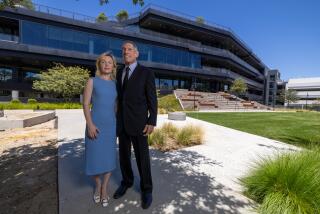SIMON ART COLLECTION A BONANZA FOR UCLA
- Share via
Fabled master art treasures worth $750 million being donated to UCLA by Norton Simon would make the institution the recipient of the largest gift ever made to a university, UCLA chancellor Charles E. Young said Friday.
Young confirmed, at a morning press conference in the Wight Art Gallery on campus, rumors that Simon has decided to give his world-renowned art collections to the local university. He emphasized that the understanding between the university and Simon was an “agreement in principle” that has not been formally confirmed. But in a telephone interview before the public announcement, he said that discussions were “very far along. It is time for lawyers and developers to sit down and work out detailed terms and provisions.”
“The depth, breadth and quality of of the whole of these collections is magnificent,” Young said. “UCLA would quickly become home to the greatest university-based art collection in the world.”
Simon’s collections, amassed since about 1964, are generally acknowledged to constitute the finest connoisseur’s compendium of Old Master, classic modern and rare Asian art put together by one person in recent decades. They have become noted because of million-dollar auction prices but are treasured by scholars and cognoscenti for the intelligence and sensitivity of their selection.
The outline plan for the future of the collections, according to Young, would be for much of it to remain in its present home in the Norton Simon Museum in Pasadena, to be administered by UCLA and the present boards of the museum and the Norton Simon Foundation, a plan applauded by Pasadena Mayor John C. Crowley who said he was delighted that Simon’s “magnificent art” would remain in Pasadena.
Young said that the university plans to build a separate museum on campus “for expanding scholarly and public access to parts of the collection not presently on view.” He indicated that the university would raise funds for the building, but declined to state specifics.
He envisioned the campus museum as being at least equal in size to the present Wight Art Gallery with appropriate space for expansion and parking. At about 14,000 square feet, the Wight gallery is only about a quarter the size of the Simon Museum. It was not immediately clear if the Simon treasures would be portioned out equally between the two showplaces or if the campus museum would tend to a scholarly study collection. Young said discussions had not reached such detailed considerations.
Neither Simon nor his wife, Jennifer Jones, was on hand for the morning conference. Simon just turned 80 and has been ill, but said in a prepared statement, “I want to be assured that our collections live, not just survive. The university can lend vitality to these great works of art. I believe deeply in education and feel that it is most fitting to devote our art collections to its service.”
Young said he thought Simon’s decision to cede these “stupendous” works to UCLA was based on the collector’s long association with the university. A long-time benefactor, Simon sat on the university board of regents for 16 years.
The university’s astonishing windfall brought a sigh of relief to a local art sphere that has sometimes feared Simon’s renowned collections might be dispersed at auction or donated in another location, but the suddenness of the announcement triggered new concerns.
Young firmly denied a printed speculation that Simon’s move to UCLA might be a ploy to trigger counter-offers from elsewhere. “This is not a negotiating ploy on either side,” he said, pointing out that his discussions with Simon had been going on for five years.
Observers also wondered about the unversity’s ability to insure and maintain such valuable works since premiums are high and the yearly cost of just keeping a museum’s doors open can run to hundreds of thousands of dollars.
“Some resources will come from a Simon gift of income-producing property,” Young said. “We will increase our support and perhaps expand our community fund-raising efforts such as those of the UCLA Arts Council. I think we can manage.”
Asked if he foresaw any snags in the process of gaining the approval of both the UC regents and various Simon foundation boards, Young said, “Those things are not just routine but we have come to a point of substantial agreement.”
More to Read
The biggest entertainment stories
Get our big stories about Hollywood, film, television, music, arts, culture and more right in your inbox as soon as they publish.
You may occasionally receive promotional content from the Los Angeles Times.










